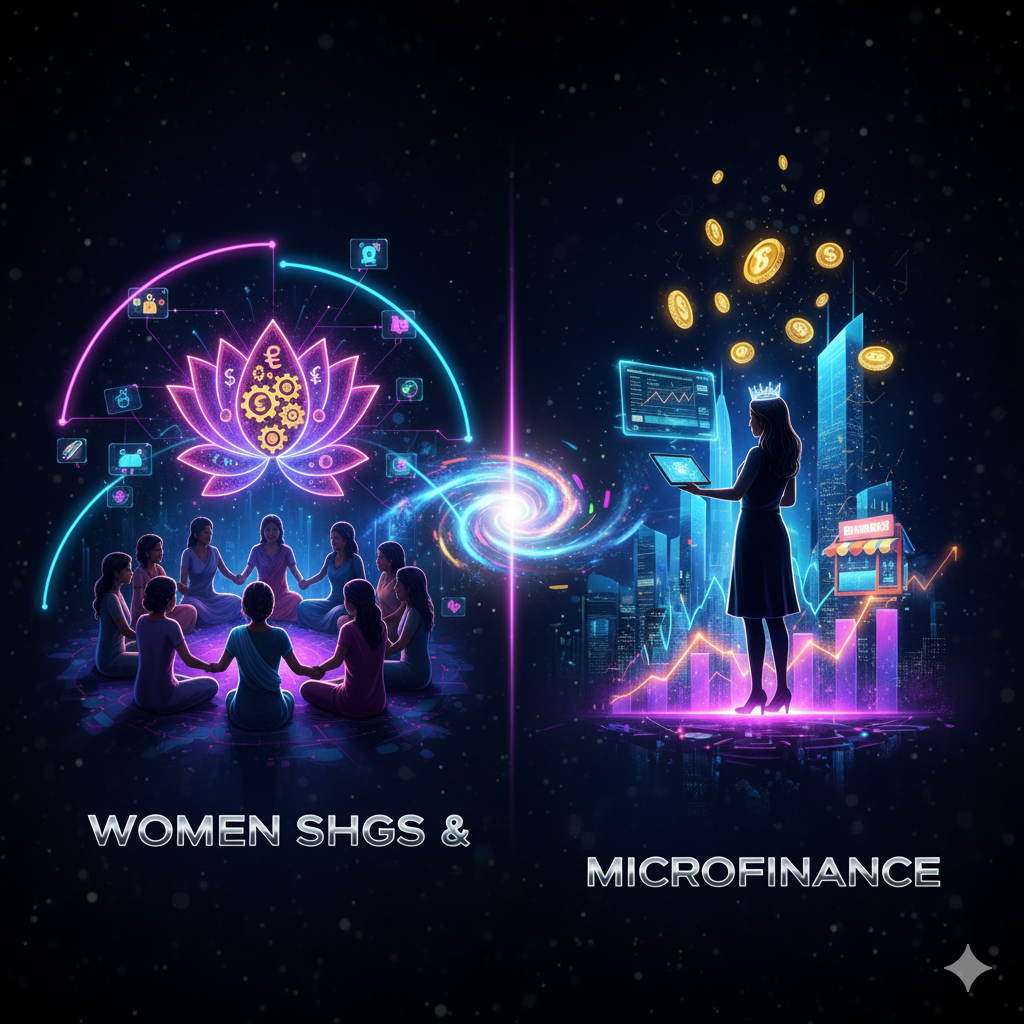Inclusive growth refers to a growth process that is equitable, where the benefits of economic development are shared by all segments of society, particularly the disadvantaged and marginalized groups. In other words, inclusive growth aims to ensure that the fruits of economic progress reach all levels of society, not just the affluent or the urban elite, but also rural populations, women, minorities, and other vulnerable groups. This concept is integral to sustainable development as it promotes the idea of equal opportunities, poverty reduction, social inclusion, and overall well-being for all citizens.
In the context of India, inclusive growth focuses on reducing inequalities in income, wealth, and access to resources while promoting broader participation in the economy. India, being a developing country with a large population and diverse socio-economic conditions, faces multiple challenges in achieving this goal.
Key Features of Inclusive Growth
- Equity: This is the cornerstone of inclusive growth. It seeks to ensure that the benefits of economic growth reach all sections of society, including those who have traditionally been excluded from the economic mainstream.
- Social Justice: Inclusive growth is closely tied to social justice, which means addressing historical and structural inequalities. This could include promoting education, healthcare, and employment opportunities for marginalized groups.
- Reduction in Poverty and Inequality: One of the primary objectives of inclusive growth is to reduce poverty and the income disparity between different sections of society. This could involve creating more equitable distribution mechanisms and improving access to basic needs.
- Job Creation and Skill Development: Creating employment opportunities for the underprivileged and providing vocational training and skill development programs are central to ensuring inclusivity.
- Sustainable Development: Inclusive growth is not just about increasing income levels but also ensuring that economic development does not deplete natural resources or harm future generations, promoting environmental sustainability.
Challenges of Achieving Inclusive Growth in India
Despite the significant strides that India has made in terms of economic growth, inclusive growth remains a distant goal. There are several factors that contribute to the challenges of making growth inclusive in the Indian context. These include:
1. High Levels of Income Inequality
India’s economic growth, while impressive, has been accompanied by rising income inequality. The benefits of growth have often been concentrated in specific regions and among higher-income groups, with the rural poor and urban slum dwellers being left behind. This has led to the growth of a “two Indias” narrative: one that is prosperous and modern, and the other mired in poverty and deprivation. The gap between the rich and poor in India has widened, and this has made inclusive growth difficult to achieve.
The rise of inequality can be attributed to several factors, including the concentration of wealth in urban areas, the growing importance of technology and capital-intensive industries, and the inability of the labor market to absorb large numbers of workers in high-productivity jobs.
2. Limited Access to Education and Skills Development
Education and skill development are key to providing equitable opportunities for all. However, in India, access to quality education remains a major challenge. While the country has made significant progress in increasing literacy rates, there is still a huge disparity in the quality of education across different regions and socio-economic groups. Rural areas, in particular, suffer from a lack of infrastructure and quality teaching. This educational divide results in unequal opportunities for children from different backgrounds, especially in terms of access to higher education and employment opportunities.
Moreover, skill development programs in India are often disconnected from industry needs. Many youth, particularly those from disadvantaged backgrounds, lack vocational skills and training, making it harder for them to find decent jobs in the formal sector. This contributes to higher unemployment rates among lower-income groups, making inclusive growth a difficult goal.
3. Unequal Distribution of Wealth and Resources
In India, the distribution of wealth and resources is highly skewed. A significant portion of the population, particularly in rural areas, does not have access to basic resources like clean water, healthcare, housing, and sanitation. Rural India remains largely dependent on agriculture, which is often inefficient, poorly remunerated, and prone to seasonal fluctuations. A majority of the workforce in rural areas remains underemployed or employed in low-paying jobs, resulting in the perpetuation of poverty.
Similarly, urban areas, although hubs of economic activity, have witnessed the growth of slums where basic living conditions are poor. Inequality is also reflected in the healthcare sector, where access to quality healthcare is a privilege reserved for the affluent. For the poor, public healthcare facilities often remain inaccessible or inadequate.
4. Discrimination and Social Exclusion
India’s deeply entrenched caste system and gender-based discrimination exacerbate the challenges of inclusive growth. Marginalized groups, such as Scheduled Castes (SCs), Scheduled Tribes (STs), and Other Backward Classes (OBCs), as well as women, face systemic discrimination in access to education, employment, and economic resources. While affirmative action policies have been introduced to address these disparities, there is still widespread social exclusion in both rural and urban areas.
The condition of women in India is particularly worrying, as they often face barriers in education, employment, and healthcare, alongside gender-based violence and harassment. Despite policies designed to empower women, such as reservation in education and employment, the social and cultural barriers to women’s full participation in the economy remain formidable.
5. Urban-Rural Divide
The urban-rural divide in India is another significant hurdle in achieving inclusive growth. While cities like Mumbai, Delhi, and Bangalore have seen rapid growth and urbanization, rural areas continue to lag behind in terms of infrastructure, education, healthcare, and employment opportunities. As a result, millions of people migrate from rural to urban areas in search of better opportunities, leading to overcrowding in cities and the expansion of slums.
Rural areas are often left with poor infrastructure and underdeveloped social services. Agriculture, the mainstay of rural India, faces multiple challenges, including poor irrigation facilities, inadequate access to credit, and low productivity, which keeps farmers trapped in poverty.
6. Structural Issues in the Labor Market
India’s labor market is highly informal, with a large proportion of the workforce engaged in low-wage, unorganized sectors. Informal workers have limited access to job security, social benefits, or legal protection, making them vulnerable to exploitation. Additionally, the country faces a significant skills gap, where the demand for skilled labor far exceeds the supply. This mismatch between labor market needs and skills creates an environment where inclusive growth remains out of reach for many workers.
The formalization of labor markets, alongside improvements in labor rights and better access to employment benefits, is essential to ensure that growth benefits all sections of society.
7. Political and Governance Challenges
India’s governance structure often hinders the efficient implementation of policies meant to promote inclusive growth. Corruption, poor administrative practices, and delays in the execution of welfare programs contribute to the inefficiency in ensuring that the benefits of development reach the poorest and most marginalized.
Moreover, political polarization and the lack of political will to address deep-rooted socio-economic inequalities often lead to the prioritization of short-term, populist measures over long-term reforms. Programs aimed at improving social and economic conditions often fail due to poor coordination between central and state governments, as well as bureaucratic red tape.
Conclusion
Inclusive growth is a complex and multi-faceted goal that requires overcoming significant structural, socio-economic, and political challenges. In India, the task is particularly daunting due to the sheer size of its population, its diverse socio-economic groups, and the deep-seated inequalities that exist within the country. While India has made significant progress in terms of economic growth, it must do more to address the disparities that continue to exclude large sections of society from the benefits of development.
Achieving inclusive growth in India will require concerted efforts on multiple fronts: improving education and skill development, addressing regional and gender inequalities, enhancing access to basic services, promoting equitable distribution of wealth and resources, and reforming the labor market. Additionally, political commitment and effective governance will play crucial roles in ensuring that the fruits of economic growth are shared more equitably across all sections of society. Inclusive growth should not be seen merely as a goal but as a process that can foster greater social cohesion, stability, and long-term prosperity for all.




